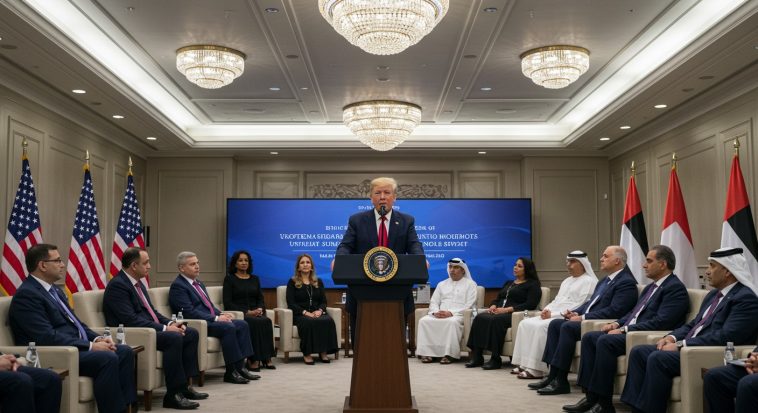DUBAI — President Donald Trump announced Friday that the United States will soon unveil new tariff rates for several trading partners, signaling a major shift in global trade policy that could have ripple effects across markets and industries.
Speaking during a high-profile business summit in the United Arab Emirates, Trump emphasized that while his administration intends to be “very fair,” the volume of countries seeking new trade deals with the U.S. is overwhelming negotiators’ bandwidth.
“It’s just not possible to meet with everyone at once,” Trump told a room of business leaders. “But we’re working on it. And soon, we’ll be telling folks what the cost is to do business in the United States.”
Trade Talks Shift Focus to Tariff Realignment
The president noted that Treasury Secretary Scott Bessent and Commerce Secretary Howard Lutnick will begin sending formal communications to international partners in the coming weeks. These letters will outline new tariff structures — essentially, the new price tags for foreign goods entering the American market.
While no specific nations were named, analysts say this move could significantly impact major U.S. trading partners, particularly in Asia and Europe.
“This could usher in a more selective and transactional era in U.S. trade,” said Marissa Chen, a trade policy analyst at Fairview Global Advisors. “The administration seems focused on reshaping access to the American consumer.”
U.S.-China Trade Truce in Limbo
The news comes as the U.S.-China tariff pause — a temporary 90-day truce — remains in effect, but uncertain. Initially celebrated by investors following last week’s trade agreement with the UK, optimism has cooled.
On Friday, China’s state-backed Global Times described the 90-day timeframe as “too short,” suggesting that Beijing is eager for a longer-term resolution. Analysts believe China is seeking greater flexibility amid fears that tariffs could quickly return.
“Markets wanted clarity, but what they’re getting now is complexity,” said Daniel Morgan, a global strategist at Keystone Funds. “The U.S. seems to be recalibrating its trade model on the fly.”
India and Apple in the Crosshairs
Trade discussions are also underway with India. Trump said Thursday that the country may eliminate tariffs on U.S. products as part of a broader deal — a potential win for American exporters.
Trump also commented on Apple’s global strategy, noting that he urged CEO Tim Cook to prioritize U.S. manufacturing over expansion in India.
“Apple should be making more of its stuff here,” Trump said. “We’ve got the workforce and the technology.”
Corporate Fallout: Walmart Warns of Rising Prices
U.S. companies are already feeling the squeeze. Retail giant Walmart warned on Thursday that tariff-driven cost increases could soon lead to higher prices for consumers. The company joined a growing list of multinationals that have declined to provide second-quarter profit forecasts, citing uncertainty around global trade.
“Supply chains are getting more expensive and less predictable,” said Jennifer Alvarez, chief economist at Retail Pulse. “Tariffs are essentially a tax that retailers either absorb or pass on to shoppers.”
Middle East Visit Opens New Tech Doors
Despite trade tensions, Trump’s Middle East tour offered a silver lining for the tech sector. His meetings in Saudi Arabia and the UAE are accelerating AI initiatives in the region, with chipmakers like Nvidia and AMD poised to supply the backbone of emerging artificial intelligence infrastructure.
“AI is the new oil,” said Faisal Al-Rahman, head of digital strategy at Riyadh Future Forum. “With support from American firms, we’re ready to lead the next tech revolution.”
Looking Ahead: A New Trade Era?
As Trump’s tariff reset looms, the global economy braces for a potentially disruptive phase. Businesses, investors, and governments alike are preparing for a more fragmented — and possibly more protectionist — trade landscape.
Whether this strategy results in stronger domestic industries or strained international alliances remains to be seen. One thing is clear: the cost of doing business with the U.S. is about to change.



